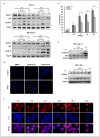Mechanistic evaluation of a novel small molecule targeting mitochondria in pancreatic cancer cells
- PMID: 23349858
- PMCID: PMC3549929
- DOI: 10.1371/journal.pone.0054346
Mechanistic evaluation of a novel small molecule targeting mitochondria in pancreatic cancer cells
Abstract
Background: Pancreatic cancer is one of the deadliest cancers with a 5-year survival rate of 6%. Therapeutic options are very limited and there is an unmet medical need for safe and efficacious treatments. Cancer cell metabolism and mitochondria provide unexplored targets for this disease. We recently identified a novel class of triphenylphosphonium salts, TP compounds, with broad- spectrum anticancer properties. We examined the ability of our prototypical compound TP421- chosen for its fluorescent properties - to inhibit the growth of pancreatic cancer cells and further investigated the molecular mechanisms by which it exerts its anticancer effects.
Methodology/principal findings: TP421 exhibited sub-micromolar IC(50) values in all the pancreatic cancer cell lines tested using MTT and colony formation assays. TP421 localized predominantly to mitochondria and induced G(0)/G(1) arrest, ROS accumulation, and activation of several stress-regulated kinases. Caspase and PARP-1 cleavage were observed indicating an apoptotic response while LC3B-II and p62 were accumulated indicating inhibition of autophagy. Furthermore, TP421 induced de-phosphorylation of key signaling molecules involved in FAK mediated adhesion that correlated with inhibition of cell migration.
Conclusions/significance: TP421 is a representative compound of a new promising class of mitochondrial-targeted agents useful for pancreatic cancer treatment. Because of their unique mechanism of action and efficacy further development is warranted.
Conflict of interest statement
Figures










Similar articles
-
Preclinical evaluation of novel triphenylphosphonium salts with broad-spectrum activity.PLoS One. 2010 Oct 4;5(10):e13131. doi: 10.1371/journal.pone.0013131. PLoS One. 2010. PMID: 20957228 Free PMC article.
-
Genistein induced anticancer effects on pancreatic cancer cell lines involves mitochondrial apoptosis, G0/G1cell cycle arrest and regulation of STAT3 signalling pathway.Phytomedicine. 2018 Jan 15;39:10-16. doi: 10.1016/j.phymed.2017.12.001. Epub 2017 Dec 5. Phytomedicine. 2018. PMID: 29433670
-
Aloe emodin exerts potent anticancer effects in MIAPaCa-2 and PANC-1 human pancreatic adenocarcinoma cell lines through activation of both apoptotic and autophagic pathways, sub-G1 cell cycle arrest and disruption of mitochondrial membrane potential (ΛΨm).J BUON. 2019 Mar-Apr;24(2):746-753. J BUON. 2019. PMID: 31128032
-
A review of the basics of mitochondrial bioenergetics, metabolism, and related signaling pathways in cancer cells: Therapeutic targeting of tumor mitochondria with lipophilic cationic compounds.Redox Biol. 2018 Apr;14:316-327. doi: 10.1016/j.redox.2017.09.020. Epub 2017 Sep 29. Redox Biol. 2018. PMID: 29017115 Free PMC article. Review.
-
Sequestsome-1/p62-targeted small molecules for pancreatic cancer therapy.Drug Discov Today. 2022 Jan;27(1):362-370. doi: 10.1016/j.drudis.2021.09.011. Epub 2021 Sep 27. Drug Discov Today. 2022. PMID: 34592447 Review.
Cited by
-
Up-regulation of hypoxia-inducible factor antisense as a novel approach to treat ovarian cancer.Theranostics. 2020 May 25;10(15):6959-6976. doi: 10.7150/thno.41792. eCollection 2020. Theranostics. 2020. PMID: 32550915 Free PMC article.
-
Antimigratory Effect of Lipophilic Cations Derived from Gallic and Gentisic Acid and Synergistic Effect with 5-Fluorouracil on Metastatic Colorectal Cancer Cells: A New Synthesis Route.Cancers (Basel). 2024 Aug 27;16(17):2980. doi: 10.3390/cancers16172980. Cancers (Basel). 2024. PMID: 39272835 Free PMC article.
-
Tumor imaging and targeting potential of an Hsp70-derived 14-mer peptide.PLoS One. 2014 Aug 28;9(8):e105344. doi: 10.1371/journal.pone.0105344. eCollection 2014. PLoS One. 2014. PMID: 25165986 Free PMC article.
-
Untangling knots between autophagic targets and candidate drugs, in cancer therapy.Cell Prolif. 2015 Apr;48(2):119-39. doi: 10.1111/cpr.12167. Epub 2015 Feb 4. Cell Prolif. 2015. PMID: 25650136 Free PMC article. Review.
-
Teaching the basics of cancer metabolism: Developing antitumor strategies by exploiting the differences between normal and cancer cell metabolism.Redox Biol. 2017 Aug;12:833-842. doi: 10.1016/j.redox.2017.04.018. Epub 2017 Apr 13. Redox Biol. 2017. PMID: 28448945 Free PMC article. Review.
References
-
- ACS (2012) Cancer Facts & Figures 2012. Atlanta: American Cancer Society.
-
- Moore MJ, Goldstein D, Hamm J, Figer A, Hecht JR, et al. (2007) Erlotinib plus gemcitabine compared with gemcitabine alone in patients with advanced pancreatic cancer: a phase III trial of the National Cancer Institute of Canada Clinical Trials Group. J Clin Oncol 25: 1960–1966. - PubMed
-
- Senderowicz AM, Johnson JR, Sridhara R, Zimmerman P, Justice R, et al... (2007) Erlotinib/gemcitabine for first-line treatment of locally advanced or metastatic adenocarcinoma of the pancreas. Oncology (Williston Park) 21: 1696–1706; discussion 1706–1699, 1712, 1715. - PubMed
-
- Plunkett W, Huang P, Gandhi V (1995) Preclinical characteristics of gemcitabine. Anticancer Drugs 6 Suppl 67–13. - PubMed
Publication types
MeSH terms
Substances
LinkOut - more resources
Full Text Sources
Other Literature Sources
Medical
Miscellaneous

